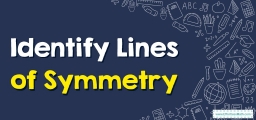Exploring Line and Rotational Symmetry
Geometry often shows us interesting patterns in shapes and figures. Two of these patterns are line symmetry and rotational symmetry. Simply put, line symmetry means if you draw a line through a shape, both sides mirror each other. Rotational symmetry means a shape can be turned or rotated and still look the same. In this blog, we'll take a closer look at both of these concepts, understanding their basics and seeing them in action.

Step-by-step Guide: Symmetries of a Figure
Defining Symmetry:
Symmetry in a figure exists when there’s a transformation, such as reflection, rotation, or translation, that maps the figure onto itself.
Types of Symmetry:
- Reflective Symmetry (Line Symmetry): A figure has line symmetry if there’s a line (called the line of symmetry) where one half of the figure is a mirror image of the other half.
- Rotational Symmetry: A figure exhibits rotational symmetry if it can be rotated (less than a full turn) about a point and still look the same. The number of positions in which the figure looks identical during a 360° rotation is called its “order”.
- Translational Symmetry: Some figures, especially patterns, can be shifted or slid in a particular direction and still look the same.
Identifying Symmetry:
- For Reflective Symmetry: Try folding the figure along potential lines of symmetry. If the sides match perfectly, you’ve found a line of symmetry.
- For Rotational Symmetry: Rotate the figure about a central point. If it fits into itself in more than just the starting and 360° positions, it has rotational symmetry.
- For Translational Symmetry: Look for repeated patterns or shapes that are shifted in the same direction without any rotation or reflection.
Examples
Example 1: Reflective Symmetry in a Rectangle
Given: Rectangle \( ABCD \)
Solution:
A rectangle has two lines of symmetry: one that bisects it horizontally and one that bisects it vertically.
If you fold the rectangle along either of these lines, the two halves will coincide perfectly.
Example 2: Rotational Symmetry in a Regular Hexagon
Given: Regular Hexagon \( XYZABC \)
Solution:
A regular hexagon has rotational symmetry of order \( 6 \).
When you rotate it about its center by \( 60^\circ \), \( 120^\circ \), \( 180^\circ \), \( 240^\circ \), \( 300^\circ \) or \( 360^\circ \), the hexagon fits onto itself.
Practice Questions:
- Does an equilateral triangle have rotational symmetry? If yes, what’s its order?
- Identify the lines of symmetry in a square.
- Examine a patterned wallpaper. Does it exhibit translational symmetry?

Answers:
- Yes, an equilateral triangle has rotational symmetry of order \( 3 \).
- A square has four lines of symmetry: two that bisect it diagonally and two that bisect it horizontally and vertically.
- This answer is subjective and depends on the pattern of the wallpaper. However, most patterned wallpapers are designed to have translational symmetry.
Related to This Article
More math articles
- 7th Grade Common Core Math Worksheets: FREE & Printable
- The Best Teacher Desks in 2024
- The Best Webcams for Teachers and Online Students
- The Ultimate 6th Grade MCAP Math Course (+FREE Worksheets)
- Stem –and–Leaf Plots
- A Comprehensive Guide to Learning How to Add Three or More Fractions with Unlike Denominators
- Derivatives Demystified: Everything You Need to Know
- Full-Length ACT Math Practice Test
- 6th Grade Georgia Milestones Assessment System Math Worksheets: FREE & Printable
- Special Right Triangles

















What people say about "Exploring Line and Rotational Symmetry - Effortless Math: We Help Students Learn to LOVE Mathematics"?
No one replied yet.